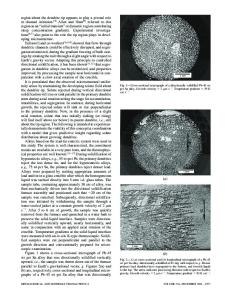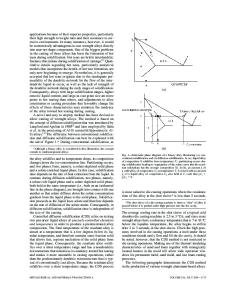On controlled solidification studies of some TiO 2 binary alloys
- PDF / 3,106,819 Bytes
- 12 Pages / 612 x 828 pts Page_size
- 84 Downloads / 370 Views
TiO2 single crystal fibers in the 1 mm diameter range were pulled from different alloy melts using the laser heated pedestal melting technique. The alloying elements studied were CaO, MnO, MgO, SiO2, FeO, and A12O3. Phase diagram solute partition coefficient, k0, maximum solid solubility limit, C,s(max), eutectic concentration, CE, and eutectic temperature, TE, were determined for each of these alloys. Solute redistribution effects in the solid, controlled precipitation in the solid, smooth solid-liquid interfaces in the presence of high melt concentrations and substantial crystal broadening by fluid migration up the solid from the melt all indicated the existence of a very strong thermodynamic field and a large solid diffusion coefficient operating in the solid behind the solid/liquid interface.
I. INTRODUCTION Considerable attention is being given, today, to ceramic processing for a host of electronic, structural, and magnetic applications. Although most of this attention is being focused on ceramic powders, one can anticipate that some future applications will be directed toward the use of single crystals. In this area, much less experience is available and, although some phase equilibria information is present in the form of phase diagrams, the situation today is similar to that which existed in the early days of the semiconductor industry; i.e., the solidus lines generally showed zero solubility, and great uncertainty existed with respect to the liquidus lines at small concentrations. To prepare the way for a ceramic single crystal technology, more fundamental information is needed concerning solute partition coefficients, liquidus slopes, solid solubility limits, interface morphology transitions, crystallization peculiarities associated with this class of materials, etc. Such a crystal technology is not likely to be based on growth via the flame-fusion technique but via a technique related to the Czochralski method of crystal growth because this is known to have the potential for producing high quality single crystals. In the present paper, TiO2 has been chosen as a model solvent, while CaO, SiO 2 , A12O3, MgO, FeO, and MnO have been chosen as typical solutes. The crystal growth has been via a vertically held molten zone with the laser-heated pedestal growth method1 and the initial goal has been to obtain solute partition coefficients, ko, solid solubility limits, Cs(max), eutectic concentrations, CE, eutectic temperatures, TE, as well as a variety of more general survey information concerning a
>EG&G-Santa Barbara, 130 Robin Hill Road, Goleta, California 93117.
980
http://journals.cambridge.org
J. Mater. Res., Vol. 7, No. 4, Apr 1992
Downloaded: 26 Mar 2015
phase particle morphologies and unique crystallization features associated with these alloy systems. Several novel crystallization phenomena have been uncovered during this initial study. II. EXPERIMENTAL The laser-heated pedestal growth (LHPG) system of Feigelson et al, '~4 in pure O 2 , air, or argon, has been used to grow round single crystals i
Data Loading...











